
page 2 of 2
|
This page includes images
of the final Sciff book's full page illuminations and the binding
process.
|
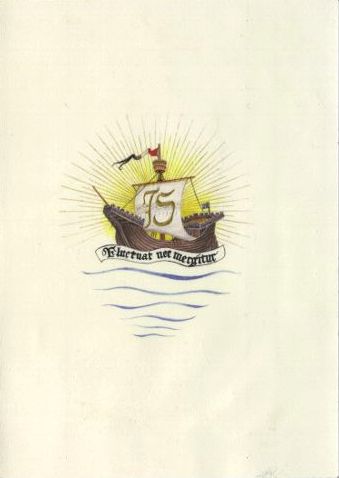 The fronticepiece is a
badge depicting a ship. The sail bears the initials of the client JS
and the motto supports the ship on waves of genuine lapis lazuli.
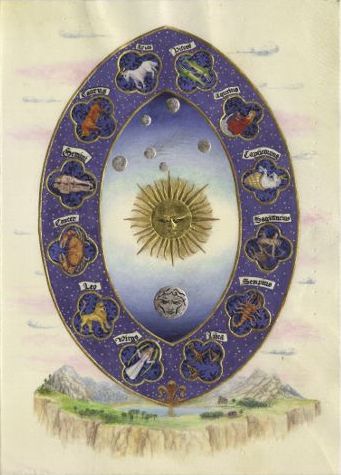 The
second magor illumination is a zodiac page. The sun and moon are gilded
with genuine gold and silver leaf on three dimensionally raised gesso.
The sky is a combination of lapis lazuli and azurite. The night sky is
warmed with a hint of insect red. The soft yellows are weld lake, and
the deepest blues are made from genuine English woad. In the landscape
many greens were used, but prominent among them is Iris Green that I
made from purple Iris Germanica petals according to a late 14th c.
recipe from Italy.
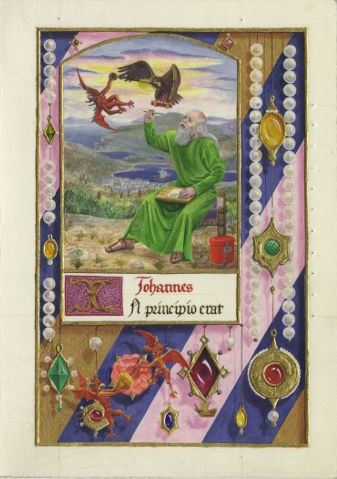 The John
on the Island Of Patmos shows John being interrupted from his copying
of the Book of Revelations by a devil who has stolen his ink pot and
penner set. The Eagle who dictates the story is
fighting
to get it back. Below John, on the border are two demons attempting to
steal the gems out of the painting. All of the many colors you see in
this art are the same as would have been used about 1500 AD in northern
Europe except the cochineal from Mexico, but that was very similar to
the European cochineal and Kermes insect colors in common use at the
time.
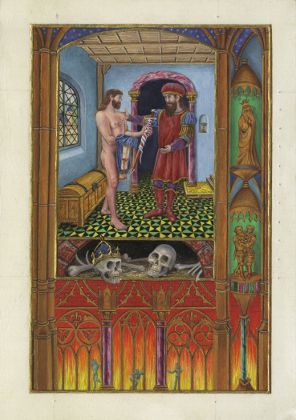 This
illustration depicts Saul's son Johnathan making a covenant with David.
He presents David with his clothing and sword. Their lasting bond is
symbolized by the skulls in the foundation below. In the border at
right King Saul scoffs while below him David embraces Johnathan.
Through the widow we see more of the palace, and below are nude figures
of the dead in the flames of impiety. David's robes are painted
in a red I made from madder roots. The floor used weld (Aarzica) yellow
and malachite.
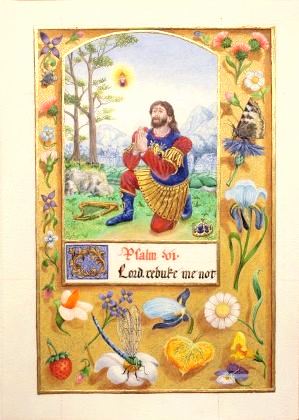 Psalm VI is David in his
Penance. He is dress in armor painted with my lapis lazuli and madder
root red. The city of Jerusalem in the background is also lapis shaded
with woad. Arzica lake pigment from weld plants is a prominent yellow
in the figures, and the cornflower supporting the butterfly is pained
with blue made from cornflowers, so it actually is exactly what it
looks like. He prays to a miniature of God appearing in the sky
above him on a golden nimbus made from buckthorne yellow.
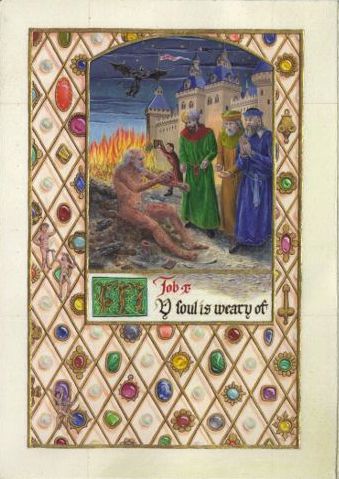 Here is
Job on the dung pile, being comforted by his friends as he scrapes away
a boil on his skin with a piece of broken pottery. A demon flies
overhead, laughing, but Job just accepts it all. In ancient times the
filth, including all trash and dung, was just tossed outside of the
cities and burned. That is why sometimes the scene says "dung pile" and
at other times "trash heap." In the background a peasant tosses
more trash on the fire. It is visually in line with Job's head as a
symbol of being dumped on directly. In the border gems are almost every
color that I own. Arzica, yellow buckthorne, sap green, verdigris,
madder, red lead, azurite, lapis, cornflower, carmine, gold, malachite,
sap green, and many more are featured. Many are very precious,
expensive and rare.
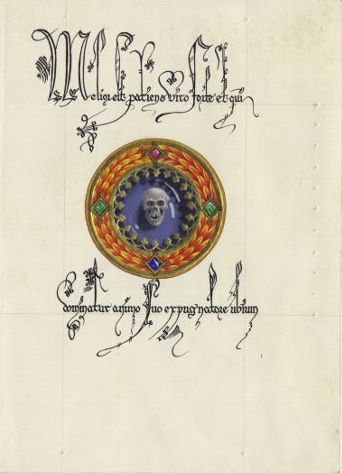 The
final illumionated page of the Schiff book is this Memento Mori, a
reflection of Death in the mirror to remind us all that we are mortal.
From the dust we came, and to dust we shall end. The Litera Bastarda
script is flourished with cadels.
The 15th c. Gothic Binding of the Schiff Book 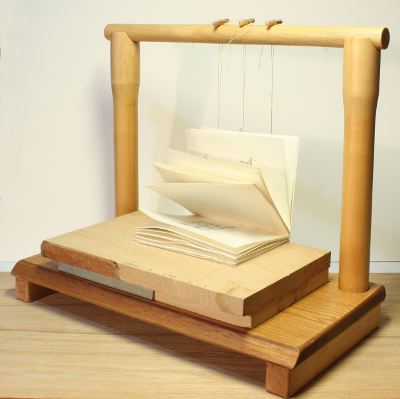 I built
a medieval sewing frame so I could get the feel of medieval
bookbinding. Notice the lack of screws to raise and lower the bar. They
are uneccesary. The book block is supported on two boards to raise it
enough to get my hand into the book comfortably. The book block is sewn
with linen thread onto soft leather thongs which are suspended between
the cross bar and through a slot on the base board, where they are
pinned.
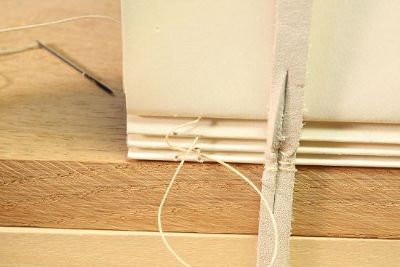 The
quires (folded gatherings of pages)
are sewn with authentic weight linen thread to leather things. These
thongs are split and wrapped by the threads. We see fake raised ridges
on the backs of fine books today because in the old days these were the
structure that made the ridges. The quires are added one at a time
until the whole book block is secured to the thongs. Sometimes double
cords were used on gothic bindings.
 In the
middle ages the typical method for triming the book block was to use a
draw knife. This made the book edges flat because when the gatherings
are folded the innermost of the nested pages stick out further than the
ones on the outside wrapping around them. This produces a dog-ear
effect, so it has to be shaved down.
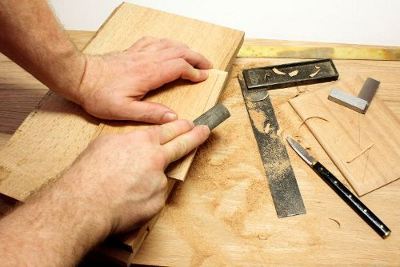 The wood
boards are shaped by hand, and then holes and channels are carved by
hand in them so that the leather thongs can be woven through them. The
leather will be flush with the surface when finished.
 As the
thongs are laced through the heavy oak boards of the cover, I glue them
with hide glue and secure them with wooden pegs seen being pressed in
place. When all is dry, the pegs and remaining tails of the leather are
sliced away. Then the spine will be lined with parchment on the
outside, and I usually fill the gaps flush with gesso so I can tool the
leather cleanly.
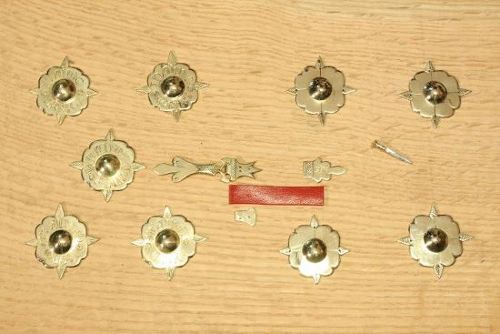 I made
the bosses for the cover of the Schiff book from brass. In this image
you can also see the intricate carved brass clasp hardware and strap..
These will all be attached to the wood with trenails.
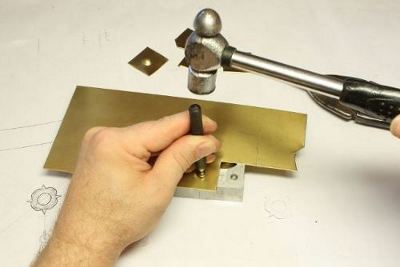 The
domes on the Sciff book were made by dapping. This is a process where I
pound a ball die into a half round cavity. Once the dome is right, I
then cut out the shape with a jeweler's saw and file it. The
medieval artisan would have used a chisel to cut it. You can see the
inked design on the left. .
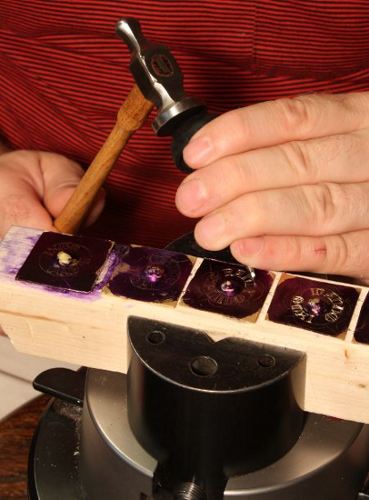 I hand
engraved the scripts on the Schiff Book bosses the old fashioned way,
with chisel gravers. The brass is inked so I can see what I am doing.
On other books I have used acid etching, but that is later period than
most of the books I make.
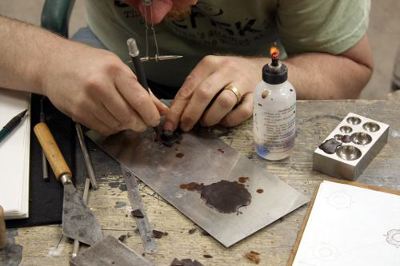 I also
make bosses and clasp hardware by lost wax casting. I have been doing
this at the studio of a fellow artist who has the facilities to do
substantial bronze casting. Many medieval bosses were cast rather than
cut. In the picture above, I am making the original wax models. These
were then cast and used to make molds for pouring a great many waxes..
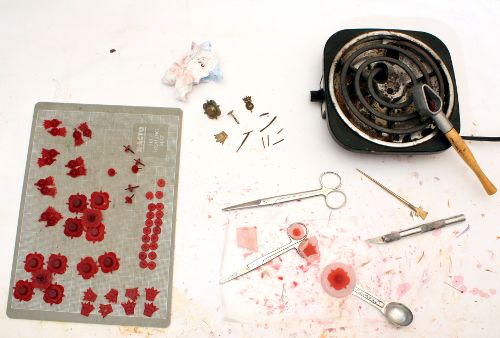 This is
a small amount of wax models being produced back in my own studio. The
next step is to attach them to sprues of more wax. The sprue is the
branch system that metal flows through on its way to the pieces inside
the mold..
 This is
my friend Tomak of Nethercraft Studio pouring molten bronze into the
large ceramic mold for my pieces. When it cooled I next broke off the
ceramic with a hammer and chisels. Pieces fly everywhere! I need to
wear goggles..
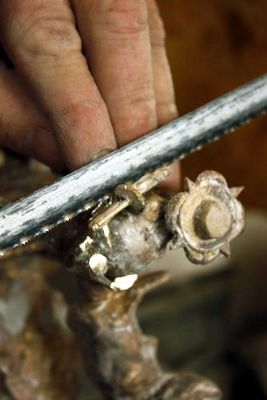 Sawing off the pieces from the sprue tree. They need a lot of clean-up with files and polishing. 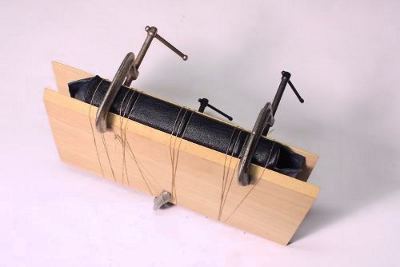
The dark
blue goat skin has been adhered over the wooden boards with wheat
paste, but the edges have not been turned in yet. The ridges of the
spine are given definition by tightly tying the wet leather with cords.
The bevel edged boards are used to keep the cords from also marking the
face of the book.
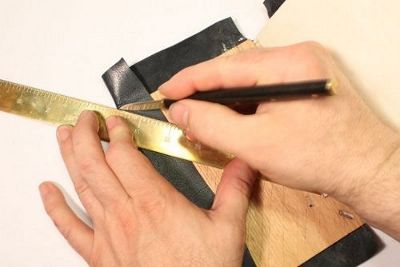 The flaps are called
turn-ins. They are pasted down and the corners mitered. While still
wet, the leather at the joint is pushed together to obscure the seam.
The book is closed and allowed to dry. Then the harware is attached wit
trenails. I bury the ends of these into channels so they do not dent
the pages in the book and cause wear. If the book will be tooled, it
must be tooled before the hardware is attached. When you look at some
of the covers done for the Jeanne d'Arc books you will see some have
gem stones inlaid into the covers. I also inlay colored leathers. .
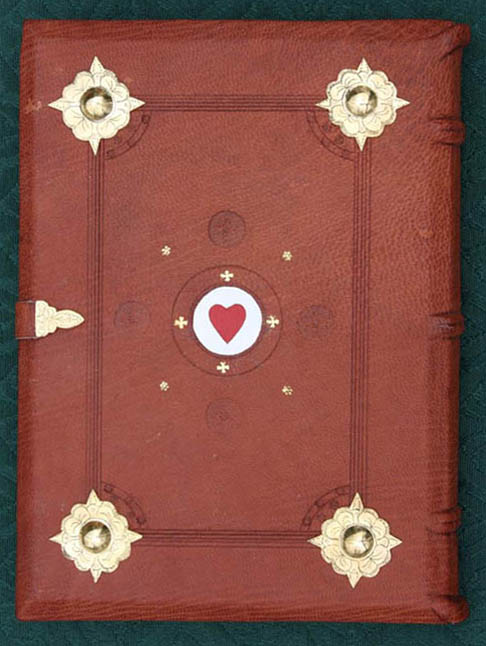 A book of love themes. Back cover showing red and white leather inlay. |